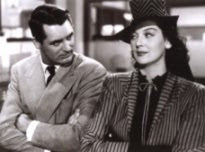Credit: Francois Duhamel/Walt Disney Pictures
Pamela Lyndon Travers (1899-1996), below, was an Australian-born, British-based actress, journalist and novelist - she created the beloved "Mary Poppins" - and a handful. Her famous book was something of a fabulist's autobiography in which Travers traced over memories of her sad childhood to create something more magical and, for her, more tolerable.
She was so driven by her affection for her beloved father, Travers Goff - and so willful in her need to overlook his flaws - that she changed her name in his memory, Born Helen Lyndon Goff, she redefined herself as P. L. Travers and, in that incarnation, she continually challenged her loyalty to her father. Her greatest test came when, plagued by financial troubles (her books had stopped selling), she entertained the suggestion by Walt Disney to turn her most precious possession - her book (and, by extension, her father) - into a big, slick, family-friendly Hollywood film. She went into this kicking and screaming.

In bringing the story of "the making of 'Mary Poppins" to life on screen, the director John Lee Hancock filmed two separate movies, alternating between 1901 Australia and the story of the fierce devotion shared by little Helen (the preternatually gifted Annie Rose Buckley) and her father (an excellent Colin Farrell, below with Buckley), and 1961 Hollywood, where Travers (a towering Emma Thompson) would knock heads with Disney (good, gray Tom Hanks) and his creative "Poppins" team.
Travers' incorrigible, obstructionist behavior had everything to do with daddy issues and, in Disney, she grudgingly found a willing father figure.
Each movie here has its own ambiance, thanks to the distinctive looks and sounds contributed by cinematographer John Schwartzman and composer Thomas Newman, respectively, and it's fascinating to observe how little, throwaway details in the "Poppins" film both complemented and contrasted with Travers real-life, death-tinged story. Travers' father was a failed banker but she blamed his failure on the assorted banks that employed him and she went further, demonizing the idea of money. And for her, Disney represented money. Not a good thing. Guilt by association.
And the father in "Poppins" could not be a negative one. "Why must he be cruel?," Travers asks of Mr. Banks. "Why?"
One of the more witty touches in the film is whether or not David Tomlinson, who played Mr. Banks, Travers Hoff's alter ego, in "Poppins," should be clean-shaven like Travers' father or have a mustache which Walt preferred - you know, sort of like his own. One can only guess about the veracity of "Saving Mr. Banks" - Travers is pretty much vilified, while Disney is spared any criticism - but on its own terms, it works.
With Thompson's scrappy, starchy yet quite vulnerable Travers in command, "Saving Mr. Banks" emerges as an unexpectedly powerful film biography, one old-fashioned, menalcholic in design and yet artfully, fastidiously done. I'm confident that P.L. Travers would approve.
It's a surprising discovery.
Note in Passing: The film's terrific ensemble includes the fetching Ruth Wilson as P.L./Helen's mother in the alternate movie and Rachel Griffiths as a take-charge aunt who was probably the inspiration for Mary Poppins; Bradley Whitford as "Poppins" scenarist Don DaGradi; Jason Schwartzman (half-brother of the aforementioned John) and B.J. Novak as the song-writing Sherman Brothers; Paul Giamatti as P.L.'s chauffeur in Hollywood, and Kathy Baker & Melanie Paxson as two Disney secretaries.




















8 comments:
There's been a lot of commentary about the scene of Travers in the film watching "Mary Poppins" in tears. I've read where the film implies she creid because she loved the film, while some critics insist she cried because she hated it. Any thoughts?
My theory is that, once again, it's all about her father. She cries because the film unleashes memories, even though she's trying to resist it.
I agree with Joe. I just got home from seeing it and it's a very powerful scene.
This is a fine, ol-fashioned film that should make both Travers and Disney happy. It's probably a compromise of what really happened, yes, but it works, mostly through the sheer will of the two leads
Coincidentally, the two current movies that my wife and I want to see are this one and "American Hustle." So many thanks for thoughtfully providing us with your excellent reviews of both!
In a recent Los Angeles Times story about "Saving Mr. Banks," Emma Thompson describes Travers telling Disney, after the two attended the "Mary Poppins" premiere, that they have "a lot of work to do" on the movie. "That ship has sailed, Pam," was Disney's response. That might be my favorite Disney anecdote.
To the best of my recollection, Bill, that exact exchange is in the film.
I'm glad you mentioned how Disney was spared. I found this to be a very one-sided, pro-Disney film. For that reason, I just couldn't buy into it.
But, Sheila and Joe, Walt Disney was not spared. Towards the end of the film Mrs. Travers hands her driver, Ralph, a list of accomplished people with "difficulties" in hopes to inspire his disabled daughter. Included on the back of the list was Walt's name - as she explained, "Deficiencies in concentration and hyperactive behavior. Explains everything!" We first see her condemnation of his philosophy as soon as she enters her hotel room - she quickly stuffs every piece of Disney artifact into the closet. And her most brutal criticism probably happens during their first meeting when she refers to his films as "silly cartoons." The entire film is riddled with her criticism of Mr. Disney and his empire. That stark contrast is what makes her character so resonant with what many might agree as a superfluous, ghastly corporation of a money mongering toy company. The film is shown from both points of view, Mrs. Travers', and Walt's, however it can't help but show her as the criticized, difficult author because that is in fact, who she decided to be in order to "save" Mary Poppins from ruin.
Post a Comment